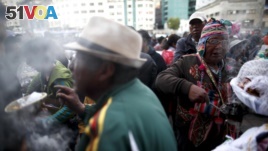08 February 2020
As they wait for a food seller to cook their food, members of a family pour a small amount of their drinks on the ground. Then, they each take a taste.
The family is on vacation at Lake Titicaca in La Paz, Bolivia. The pouring is a small offering to Pachamama. In return, Pachamama is said to bring blessings.
In South America's most indigenous country, a belief system called Pachamama is part of everyday life. Pachamama is a goddess beloved by people of the Andes Mountains. She is also sometimes known as Mother Earth.
Pachamama represents the earth's fertility. She rules over the planting and harvesting of crops, as well as the mountains. She also causes earthquakes.
The word "pacha" means earth, cosmos, universe, time and space in the indigenous languages of Quechua and Aymara. The second part -- "mama" -- means mother.

In this picture taken Monday, Jan. 6, 2020, spiritual indigenous guides perform a blessing on baby Jesus dolls after people leave the Three Kings Day Mass outside the San Francisco Church in La Paz, Bolivia.
Belief in the earth goddess can be found in other parts of South America such as Peru and Chile.
In Bolivia, at least 60 percent of people trace their ancestors to native tribes that lived in the area when Spanish colonizers arrived. Many ethnicities, in both major cities and small villages, believe in Pachamama. Parents teach their children that gratitude for Mother Earth must be a central part of their lives. Many are practicing Catholics who join the customs together.
"It's a combination," Jose Luis Campero told The Associated Press. He is a 30-year-old engineer from La Paz who is Catholic. "God is not just one religion."
Through rituals known as "challas," Bolivians show respect for Pachamama by pouring drinks and throwing flowers and coca leaves on the ground. Challas sometimes include songs or dances.
Jose Saravia, a 46-year-old engineer from La Paz, said he and his coworkers always say a blessing for Pachamama before starting new building projects.
"We give thanks to Pachamama so Pachamama gives us blessings. That's a tradition from our ancestors," Saravia said. "We go to Mass because the Spaniards brought the Catholic Church to Bolivia."
In Bolivia, Pachamama is everywhere, yet nowhere. There is no official painting, image, flag or statue in public places or inside homes. Yet people often honor and include it in Christian religious events.
There are some ways in which Pachamama is seen in daily life, however. A flag called the "wiphala" represents indigenous people. It has several colors in very small squares. Under Evo Morales' presidency, it became an official government flag along with the three-colored red, yellow and green Bolivian flag.
The belief system enjoyed renewed attention and celebration under Morales' nearly 14-year presidency. During that time, he performed Pachamama offerings at official government ceremonies. In 2019, an animated film called Pachamama was released on Netflix. It told the story of a 10-year-old Andean boy during the time of the Spanish conquest of Bolivia.
The mix of Christian and ancestral religion came from indigenous Bolivians who had to hide their beliefs under Catholic ones. But it has become more common in recent history to publicly celebrate both.
This was especially true during Morales' presidency. The mix of religions is recognized by Bolivia's constitution under the term "Andean cosmovision." And it is widely practiced.
Morales angered some Catholics when he rewrote the constitution in 2009. He removed special recognition that had been given to the Roman Catholic Church.
But the move did not seem to anger local Bolivian Catholic religious leaders. Instead, they respect the relationship that exists between the two belief systems.
The church's current mission is to avoid confrontation and try to better understand the Aymara/Inca culture, said Abelino Yeguaori, a local friar.
Not far from Yeguaori's church, an indigenous guide pours a drink on the ground to bless a woman and her husband in their prayer for a new home.
I'm Alice Bryant.
Brady McCombs wrote this story for The Associated Press. Alice Bryant adapted it for Learning English. Ashley Thompson was the editor.
__________________________________________________________
Words in This Story
indigenous – adj. a word describing people who are the earliest known inhabitants of an area, in contrast to groups that have settled or colonized the area
blessing – n. a prayer asking for God's favor and protection
practice – n. something that is done often or regularly
gratitude – n. a feeling of appreciation or thanks
ritual – n. a formal ceremony or series of acts that is always performed in the same way
Mass – n. the central act of worship in the Roman Catholic Church
conquest – n. the act of taking control of a country, city or something else through the use of force
animated – adj. produced by the creation of a series of drawings and pictures that are shown quickly one after another
cosmos – n. the universe especially when it is understood as an ordered system
friar – n. a member of a men's Roman Catholic group who studies or teaches about Christianity